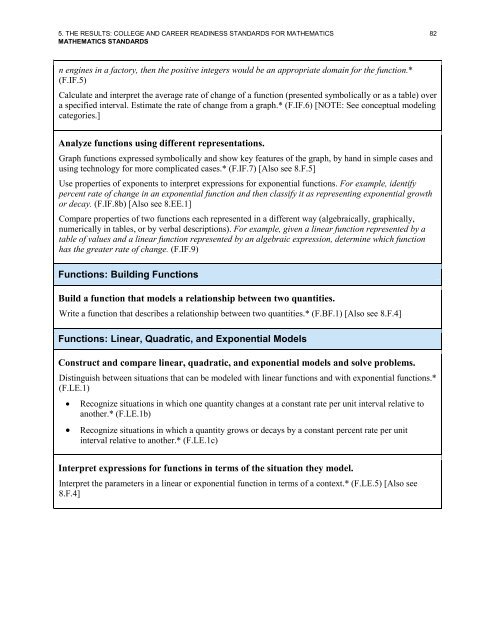CCRStandardsAdultEd
You also want an ePaper? Increase the reach of your titles
YUMPU automatically turns print PDFs into web optimized ePapers that Google loves.
5. THE RESULTS: COLLEGE AND CAREER READINESS STANDARDS FOR MATHEMATICS 82<br />
MATHEMATICS STANDARDS<br />
n engines in a factory, then the positive integers would be an appropriate domain for the function.*<br />
(F.IF.5)<br />
Calculate and interpret the average rate of change of a function (presented symbolically or as a table) over<br />
a specified interval. Estimate the rate of change from a graph.* (F.IF.6) [NOTE: See conceptual modeling<br />
categories.]<br />
Analyze functions using different representations.<br />
Graph functions expressed symbolically and show key features of the graph, by hand in simple cases and<br />
using technology for more complicated cases.* (F.IF.7) [Also see 8.F.5]<br />
Use properties of exponents to interpret expressions for exponential functions. For example, identify<br />
percent rate of change in an exponential function and then classify it as representing exponential growth<br />
or decay. (F.IF.8b) [Also see 8.EE.1]<br />
Compare properties of two functions each represented in a different way (algebraically, graphically,<br />
numerically in tables, or by verbal descriptions). For example, given a linear function represented by a<br />
table of values and a linear function represented by an algebraic expression, determine which function<br />
has the greater rate of change. (F.IF.9)<br />
Functions: Building Functions<br />
Build a function that models a relationship between two quantities.<br />
Write a function that describes a relationship between two quantities.* (F.BF.1) [Also see 8.F.4]<br />
Functions: Linear, Quadratic, and Exponential Models<br />
Construct and compare linear, quadratic, and exponential models and solve problems.<br />
Distinguish between situations that can be modeled with linear functions and with exponential functions.*<br />
(F.LE.1)<br />
• Recognize situations in which one quantity changes at a constant rate per unit interval relative to<br />
another.* (F.LE.1b)<br />
• Recognize situations in which a quantity grows or decays by a constant percent rate per unit<br />
interval relative to another.* (F.LE.1c)<br />
Interpret expressions for functions in terms of the situation they model.<br />
Interpret the parameters in a linear or exponential function in terms of a context.* (F.LE.5) [Also see<br />
8.F.4]


